Paxillus obscurisporus C. Hahn
Phylum: Basidiomycota - Class: Agaricomycetes - Order: Boletales - Family: Paxillaceae
Distribution - Taxonomic History - Etymology - Identification - Toxicity - Reference Sources
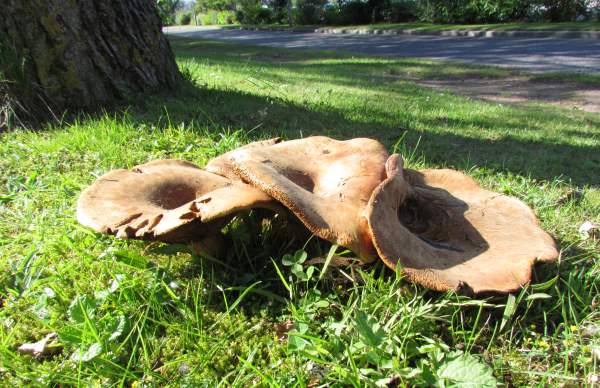
From its general shape a mature example of this poisonous gilled fungus might be mistaken for a 'funnel' (Clitocybe genus), except that its gills are brown rather than white, and its spores are vinaceous redish brown whereas Clitocybe species have white spores.
This gilled member of the order Boletales occurs most often under lime trees (Tillia species), birches (Betula species) and willows (Salix species); it produces ground-hugging caps that are usually a lot bigger than other members of the Paxillus genus.
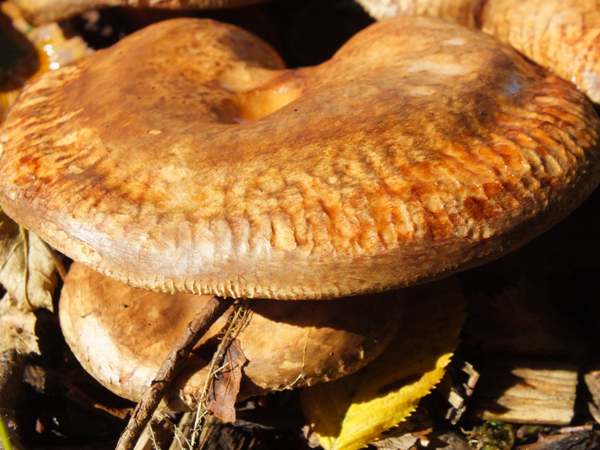
Distribution
Uncommon but perhaps not as rare in Britain and Ireland as records currently suggest, because of easy confusion with other Paxillus species the distribution of Paxillus obscurisporus is not yet well understood. This species has been recorded in other central and northern European countries including France, Germany, Poland and parts of Scandinavia.
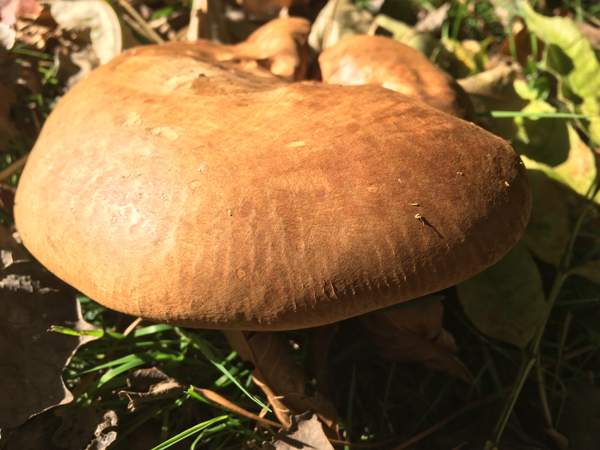
Taxonomic history
This species was first distinguished as separate from Paxillus involutus and other members of that genus by the German mycologist Christoph Johannes Hahn in 1999, who gave it the scientific name Paxillus obscurosporus, later corrected to 'obscurisporus'.
Etymology
The generic name Paxillus means a 'peg' or a 'small stake', while the specific epithet obscurisporus is a reference to the dark spore print relative to other Paxillus species.
Toxicity
Paxillus invollutus is now known to be toxic, and as this is a very close relative it seems most likely that Paxillus obscurisporus is also a toxic toadstool.
Identification guide
 |
CapInitially convex, the pale ochre cap soon becomes centrally depressed; finely downy at first, becoming smoother with age; sticky when wet. Caps expand to between 7 and 35cm in diameter - larger than other members of the Paxillus genus. |
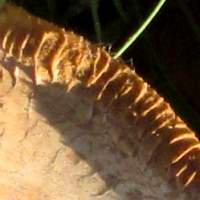 |
Cap marginInitially markedly inrolled when young but eventually almost flattening and developing increasingly distinctive broad radial grooves. |
 |
GillsPale ochre at first, the crowded, branching gills gradually turn reddish brown (rapidly so when bruised), darkening with age. Gills are decurrently attached to the stem. |
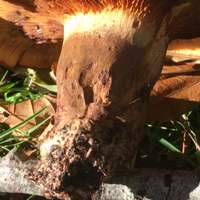 |
StemRelatively short and stout: typically 1.5 to 4cm in diameter and 3 to 5cm long, the stems are slightly downy and stain red-brown when bruised. Creamy pink mycelium is evident at the stem base. |
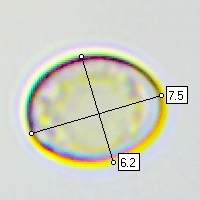 |
SporesBroadly ellipsoidal, smooth, 5-6.5 x 7-10.5µm. Spore printQuite an intense vinaceous reddish brown when taken from fresh specimens. |
Odour/taste |
Odour not distinctive; taste acidic. |
Habitat & Ecological role |
Mycorrhizal, usually under broad-leaved trees on roadside verges and in parkland. |
Season |
July to October in Britain and Ireland. |
Similar species |
Paxillus rubicundulus P. D. Orton (syn. Paxillus filamentosus) is very similar in macroscopic characters but has pale rusty brown spores 5.5-8.5 x 4-5μm; it is mycorrhizal with Alders (Alnus species). Paxillus involutus, the Brown Roll-rim, is a smaller and much more common mushroom of acid heathland and woodland; its spores are smaller and its spore print is sienna rather than the intense reddish-brown associated with Paxillus obscurisporus. |
Reference Sources
Fascinated by Fungi, 2nd Edition, Pat O'Reilly 2016, reprinted by Coch-y-bonddu Books in 2022.
Roy Watling & Hills, A.E. 2005. Boletes and their allies (revised and enlarged edition), - in: Henderson, D.M., Orton, P.D. & Watling, R. [eds]. British Fungus Flora. Agarics and boleti. Vol. 1. Royal Botanic Garden, Edinburgh.
Dictionary of the Fungi; Paul M. Kirk, Paul F. Cannon, David W. Minter and J. A. Stalpers; CABI, 2008
Taxonomic history and synonym information on these pages is drawn from many sources but in particular from the British Mycological Society's GB Checklist of Fungi.
Acknowledgements
This page includes pictures kindly contributed by Simon Harding.
Fascinated by Fungi. Back by popular demand, Pat O'Reilly's best-selling 450-page hardback book is available now. The latest second edition was republished with a sparkling new cover design in September 2022 by Coch-y-Bonddu Books. Full details and copies are available from the publisher's online bookshop...


